Windows Update helps you keep the system in up to date. It allows you to download and install updates in both automatic mode, as well as manually.
Run from command line or windows Run(WIN+R): control /nameMicrosoft.WindowsUpdate
On this page:
Notifications about available updates
Windows 7 tells you about available updates both in Windows Update and in the notification area next to the clock. In addition to the icon in the notification area (using which you can go to the update center), the system displays pop-up windows informing you about the operation of the update center.

The settings for these notifications can be configured in the Control Panel Action Center. Quick access to notification customization options can now be accessed by clicking the wrench icon.
By default, the operating system automatically downloads and installs updates. Click the link Settings in the left panel to change the settings.

Installation methods Windows updates 7 are similar to those in Vista, although the interface has changed a little - for important updates, instead of radio buttons, there is now a drop-down list. If you have selected the recommended option to automatically download updates, you can choose the time at which it will be performed. You can also define how recommended updates are received and allow all users to install updates.
By Windows default 7 is configured to automatically download and install updates without user intervention. Thus, this is the way Microsoft recommends installing updates. If you want to choose which updates to install yourself, set the option Download updates...(there is no installation) or Search for updates...(no download or installation is performed). Obviously, in the second case, you will save traffic by avoiding downloading updates you do not need. In both cases, you will need to keep an eye on Action Center notifications and install updates in a timely manner.
As for disabling the check for updates, it is highly recommended not to do this. Practice shows that most virus outbreaks would not become massive if users installed updates that fix Windows vulnerabilities in a timely manner.
Finding and installing updates
If your updates are not installed automatically, but checking for them is enabled, the update center will display information about available updates. You can also check for updates manually by clicking the link Search for updates in the left panel.

To see a list of available updates and select them to install, click the link Important updates... or Optional updates... in the central part of the information message.

Window Interface Selecting updates to install changed compared to Windows Vista - now it consists of three panels.
- The names of update categories are displayed in the left panel - important and optional, and either one or the other can be displayed in the window at the same time.
- The central panel contains a list of updates from which you can select the ones you want to install. You can also hide updates that you do not want to see in the list - the corresponding item is in the context menu of each update.
- The right panel displays information about the selected update, which is very convenient. Previously Additional information could only be opened from context menu which required additional movements. At the bottom of the right pane, there is a Details link that takes you to a Microsoft Knowledge Base article describing the update.
- At the bottom of the window, there is a status bar that shows which updates you have chosen to install.
After you decide on the list of updates to install, Update Center will display a summary of the selected updates and prompt you to install them.

After the installation is complete (and reboot if necessary), Windows 7 will notify you of the success or failure of the installation using a pop-up window.

Update log
Successful or unsuccessful updates are logged. Click the link Viewing the update history in the left pane of the Update Center to open the log.

The log displays information about the name of the update, the installation date, and whether it succeeded or failed. Detailed log windows update stored in %systemroot%\ windowsupdate.log.
Windows 8 Update not only updates your computer with the latest security and stability patches, but also updates for any other installed software. Microsoft such as Windows Essentials Suite and Microsoft office. Like Windows Firewall, Windows 8 Update has two kinds of settings that can be managed in PC Settings and Control Panel.
The easiest way to see how the center is configured is in the PC settings, section "Update and Recovery".
By default, Update Center automatically installs all critical, important, and recommended updates on your computer. There is not much left for the user to do. For the average, non-tech savvy user, it is enough to be concerned only with the protection of privacy and security.
However, more experienced users may prefer full settings update center.
Again, you can use the PC settings section to configure the center: from the start screen, search - updates, and then click on the "Select" button. Here you can select options to configure Windows Update without going to the desktop. Settings include options for obtaining the necessary updates and the type of these updates.
Windows 8 Update on the desktop.
If you want to manage the download of selected updates from your desktop, use the control panel. Here you will see all the features familiar from Windows 7, including those that are not available in PC settings.
Main Windows window Update has color marking, which immediately shows Current state computer updates.
The marking is familiar: green, yellow or red warning icon.
The window below describes when you or the system itself last checked your PC for updates, downloaded updates, and when they were installed.
Attention. Desktop Update can also check for updates to other Microsoft software, including Office and the Windows essentials suite. This feature can be enabled from the home screen.
When you're browsing the list of updates for your PC but don't know what the update is and what it will mean for your computer, click on it; on the right side of the panel you will see additional information, including the necessary links. Here you will also find out if your computer needs to be restarted after installing updates, although this is not required by default for two days.
When you install an update that requires a restart, you will be asked to select the option further action PC: sleep, restart or shutdown. Please note that a freshly downloaded update will not be installed without a restart.
In the left area of the main window of the update page, there are options available for changes. In Settings, you can set when and how Windows 8 installs updates. First, it's important to note that Windows 8, unlike more early versions operating system, when installing updates, much less PC restarts are required. In addition, two days are given to wait for the restart, in the hope that during this time you will somehow still shut down your computer. This means that fewer users will want to change the default settings in Windows 8. Although it is still recommended to leave the default settings.
The following are the four settings options for Windows update:
- Install updates automatically (recommended by Microsoft)
- Download updates, but let me decide whether to install them
- Check for updates, but leave the decision to download and install to me
- Do not check for updates.
In addition, there is a control that allows Windows 8 to install recommended updates as well as important updates. Recommended updates may include new operating system features.
You can install in the update center Windows boot following updates:
- Recommended Updates: Includes updates for system stability and updates for non-critical features
- Microsoft Product Updates: Includes software Microsoft, core components of the Windows Essentials suite, and Bing Bar for IE.
Hiding and restoring updates.
Sometimes, you may need to hide some updates so that they don't appear again. For example, when Microsoft offers additional language packs that you don't need, or a hardware driver released through Windows Update, it causes computer problems or hardware failures.
To hide any update, on the main update screen, right-click on it and then select the "hide update" option. This process will prevent this update from reappearing.
Attention. If you restore Windows 8 from an image backup or use the Refresh option, all hidden updates will become visible again. You will have to hide them again.
You can hide not only one update, but the whole group. To select multiple updates in sequence, click on the first one, and then hold down the Shift key and click on Last update in series. To select inconsistent updates, hold down the CTRL key and click on the updates you don't need.
To display all hidden updates (only all, some cannot), click "restore hidden updates" in the left pane of the main window of the update center.
Manage drivers and roll back Windows 8 updates.
As mentioned above, some updates, especially drivers, sometimes make Windows unstable. Don't worry, Windows 8 creates a system restore point while it's running, so you can always roll back to the latest restore point.
By the way, you can also create a restore point manually, for this, go to the “recovery” section in the control panel and create a restore point already in it.
Now, in case of failure with a driver update, you can restore the system to a state before this update, and by running Windows Update again, hide the problematic update.
Get updates from the Windows Store.
Updates for apps purchased and downloaded from the Microsoft Store do not appear in Windows 8 Update. All the updates they need are downloaded there.
After installation, all applications, when new versions appear, are updated automatically without notification. However, you can control this, for example, turn it off, to do this, open the store application settings in the charms, and then right-click upper corner your screen with the link to update applications. Shown here is an update panel that includes updating the controls.
Major Windows updates now also happen through the store, including the upgrade from Windows 8 to Windows 8.1.
Installing service packs for Windows 8.
About once a year, Microsoft releases a service pack for the OS or some significant update (Windows 8.1). Since the days of Windows XP, many new important features for the operating system have been added to service packs. For example, service pack 2 added to XP a new security center and a host of security-related features.
Indeed, there have been so many updates that some commentators have even said that Microsoft could sell the update package as a completely new version Windows. Windows 8.1 - again overhaul operating system and the inclusion of many new features.
Depending on the type of updates, they may come either through Windows Update or through the Windows Store, and it is not yet known exactly which long term strategy Microsoft (although most likely all updates will eventually come through the store). Windows 8 Update always notifies you when a major update is available, and while notification methods may change, you will certainly not be left without information.
1. Open the editing window group policy. To do this, use the simultaneous pressing of the Win + R keys and in the window that opens, enter gpedit, then press "Enter".
2. Open the first directory with Computer Configuration, then go to Administrative Templates, expand Windows Components and then open the Update Center directory.
3. On the right, we are looking for a policy with the name "Setting up automatic updates." Double click on it.
4. In the window that opens, move the switch to the "Enabled" line. Below there will be a section of parameters, here we set the necessary mode of work with updates. In this case, the characteristic for the selected parameter is displayed to the right.
We recommend installing the second download option - Notifications for fresh updates. When this option is selected, the system will report available updates, but any operations with them can only take place with the permission of the user himself.
5. Now you need to activate the changes made in the settings. To do this, you need to run a check for fresh updates through the Options window:

After the latest updates appear on your PC, a notification will pop up asking you to install the update.  The notification itself is stored in the Notification Center.
The notification itself is stored in the Notification Center.

Unfortunately, Windows users 10 Home will not be able to configure updates in this way. This is due to the fact that the group policy editor is simply not available in this version of the operating system. But do not be upset, you can still configure the receipt of updates and this is done through the registry editor.
1. Open the registry editor window. To do this, simultaneously press two keys Win + R then, in the next window, you must enter regedit and press "Enter".
2. Then, in the editor window, we navigate through the directories along the following path:
3. Right-click on the Windows directory and select New → Partition.
4. Specify the following name for this section: windows update.
5. In the section that we created, in the same way, you need to create another one, but with the name AU.
6. In the AU directory, in the right half of the editor window, right-click on any empty space and in the menu that opens, click Create → Parameter DWORD(32-bit).
7. This parameter must be given a name AUOptions.
8. In the same way, we create several more parameters with the following names: NoAutoUpdate, ScheduledInstallDay, ScheduledInstallTime. Optionally, you can create a parameter.
9. For all the created parameters, specify the values that depend on the desired result.
|
Parameter |
Description |
Value options |
|
AUOptions |
This setting determines how updates are downloaded and installed. | 2- notification when updates appear. 4 - everything happens automatically, but according to a certain schedule. 5 - Allows local administrators to configure notifications and boot methods. |
|
NoAutoUpdate |
With this setting, you can disable updates. | 0 - This value disables this option. 1 - this parameter value disables automatic updates. |
|
ScheduledInstallDay |
With this parameter, you can specify the date of the week for installing updates. This option will only work if the value of the AUOptions parameter is 4. |
0 - any day. 1 - on Monday. 2 - on Tuesdays. 3 - every Wednesday. 4 - on Thursdays. 5 - every Friday. 6 - on Saturdays. 7 - on Sundays. |
|
ScheduledInstallTime |
With this setting, you can specify a specific time to install updates. As in the previous case, this option works when the value of AUOptions is 4. |
Here you can specify values from 0 to 23. According to the hours. |
|
NoAutoRebootWithLoggedOnUsers |
Disables automatic restart after updates are installed. Reloading is carried out only by the user, manually. Only works when AUOptions is set to 4. |
1 - disables automatic reboot. 0 - this parameter is not active. That is, the reboot is enabled. |
Files to automatically create and configure registry settings
Downloading with files auto tuning registry and unpack it. The archive contains the following files:
1. WU_Notifu_Updates.reg– specifies the second value: notification before update operations.
2. WU_Never_Notifu_Updates.reg- this file will disable updates altogether (not recommended).
How to disable automatic installation for drivers?
This guide may help if, after automatic installation drivers, various failures and malfunctions in the system begin to occur. In such cases, disable this type of installation in order to avoid installing problematic drivers.
1. Open the Control Panel window. To do this, use the simultaneous pressing of two keys: Win + X, and then select "Control Panel" from the menu.
2. Open the System and Security section and then expand the "System" category.
Today, despite the abundance of various criticisms, Windows remains an advanced operating system, occupying a leading position throughout the world. This year, the company has provided the public with a new OS - Windows 10, allowing users of older systems to upgrade to it (the promotion is open until August 2016).
In general, the "top ten" received positive ratings, unlike its predecessor, but some elements caused some misunderstanding. One such element is the update center, which is best described as "forced".
Moreover, initial settings assume the installation of updates during the reboot, which the user is not even notified about. Naturally, no choice is given to the user.
Update system
In Windows 10, it is made so that the restart of the computer system in order to install updates occurs only if it is idle. An obvious measure that was supposed to prevent the system from interfering with the user's work.
It is worth saying that in the vast majority of situations, Windows 10 determines quite well that the computer is not in use. However, many people who need a PC to work in background, such a system will not work, as unexpected reboots will create some discomfort.
All past operating systems Microsoft Center updates was a permanent element, which was responsible for downloading and checking for the latest fix packs and device drivers from the Internet, as well as their further integration.
Previously, all of these processes were completely customizable. Even in Windows 8, the user could manually manage system updates through the control panel. You could optionally disable and enable them, and choose to download only the most serious fixes.
In the last 10 operating Microsoft system completely removed the possibility of refusing updates. In this case, of course, we are talking about setting up using the built-in interfaces - the control panel and the program " Options».
Microsoft is now the sole decision maker to update your system. The only thing that is at the mercy of the user is the ability to postpone the process of installing fixes for a certain period. But even this function is available only to the owners Windows versions 10 pro. Owners of other assemblies of the operating system do not have such an opportunity.
Setting
The operating system update center in 10 has finally moved to standard application « Options", which you can go to by clicking on the link from the menu " Start».
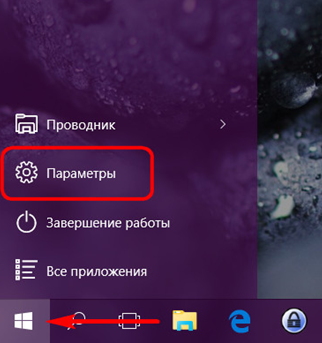
Among other settings subsections, it is located on the main screen of the program under the name " Update and Security».
Here you will find a modest amount of customizable elements:
- Enable/disable PC restart when installing fix packs. If you want to avoid a sudden shutdown of the computer, you should change this setting, as a result of which you will receive notifications before restarting the system.
- Enable/disable updates of other Microsoft programs installed on the PC. If you do not want to receive maintenance for various company products, you should disable this option.
- Postponing updates. With this option, it is possible to postpone the system update. However, system security fixes will continue to come.
In addition, the basic functionality of the OS allows you to disable the download and installation of drivers. For this you need:
- Open the Run dialog using the Win + R keyboard shortcut
- Enter the following text in the window:
Rundll32 newdev.dll,DeviceInternetSettingUi
then click on the Enter button. - In the window that appears, first select the item " No, provide a choice", then - " Never install drivers from Windows Update».
- Save changes.
After completing this sequence of actions, you will prohibit the system from searching for drivers on the Internet, and instruct them to install them exclusively from the memory of a personal computer.
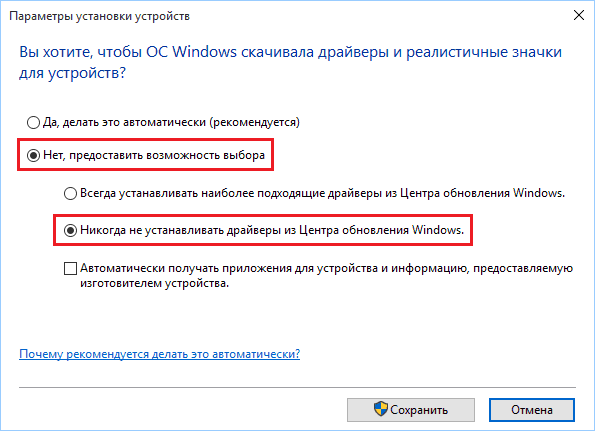
Show or hide updates tool for Windows 10
Another way to stop automatic update system is to use the Show or hide updates tool.
To do this, you should download the program from the Web and run it, which will lead to the start of a system scan, after which you should click on the Hide updates button.
The screen that appears will prompt you to select the fixes you want to hide. You should proceed in a similar way if you want to return some of the updates.
WiFi Limiting
Another method of restricting updates. To do this, you need to set up an Internet connection through a “limited” Wi-Fi channel.
To do this, you need to follow these steps:
- Open menu " Options"and go to the subsection" Network and Internet».
- Then in the subsection wireless connection go to " Extra options ' and enable the option ' Set as metered connection».
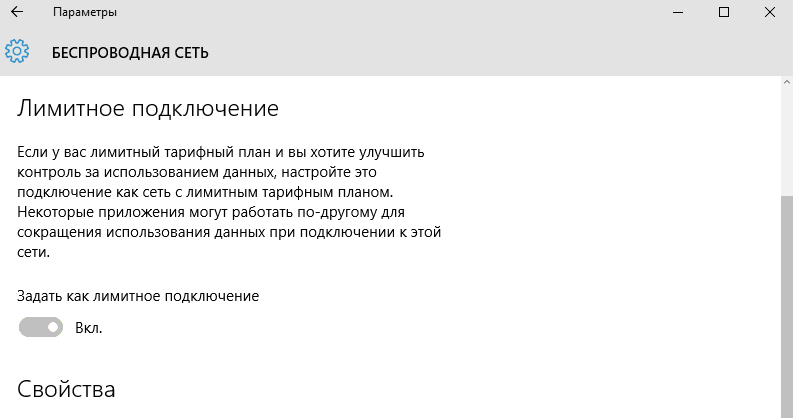
Using the Windows 10 Registry
Using the registry, you can completely disable the download of update packages.
To do this, you should perform the following operations:
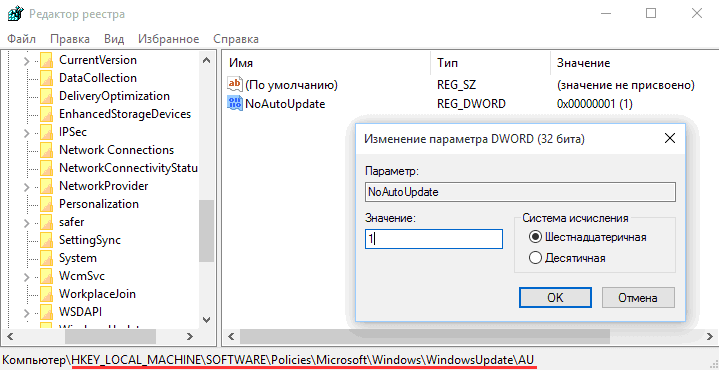
Thus, there are many options for customizing and limiting the Windows 10 update system, which more than compensates for the modesty of the built-in functionality, which has only a few adjustable options.
Related videos
Default system updates are located, downloaded and installed automatically, the computer only informs the user that the update process has been completed. Reboot to complete the installation is also performed automatically. But these and other parameters can be changed without resorting to third-party programs.
About the update center
Update Center - the place where all the settings and functions related to updating the system are located. In Windows 10, the number of settings that could be changed without third-party applications and editing the registry, compared to previous versions operating system has been greatly reduced. For example, you cannot completely prohibit downloading and installing updates using the standard method.
Also, the settings for the Windows 10 Home edition are cut down: some features available in the professional and higher versions are missing. You can find the update center only in the system settings, it was removed from the "Control Panel":
Search for available updates
There are several ways to check for updates: through the execution of commands, third party applications from Microsoft and the update center.
Via Windows Update
The standard and easiest way is with the help of the update center: just click the "Check for updates" button. If updates are found, you will receive a notification containing the name and unique code update that starts with KB. When you confirm that you want to install the updates found, they will begin downloading, and then installation, followed by a computer restart.
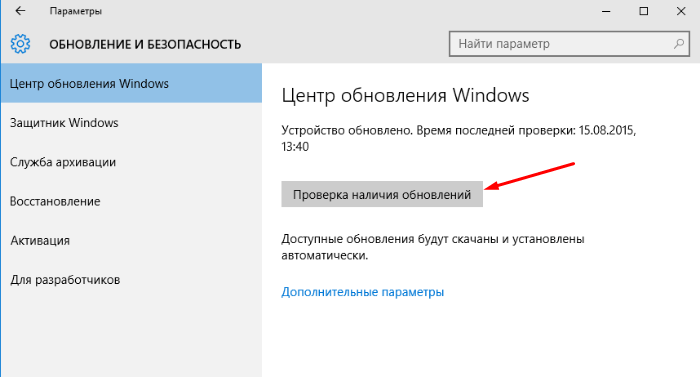 Click on the "Check for Updates" button
Click on the "Check for Updates" button The only thing that is required of you is to provide the computer with a stable Internet connection and power supply. A broken process can cause a variety of errors, which will lead to a breakdown of the operating system.
Through third party programs
If updating through the update center is not possible for some reason, use the Windows 10 Updates program by downloading it for free from the official Microsoft website. Regardless of which update method you use, information stored on your hard drive and third-party applications will not be affected.
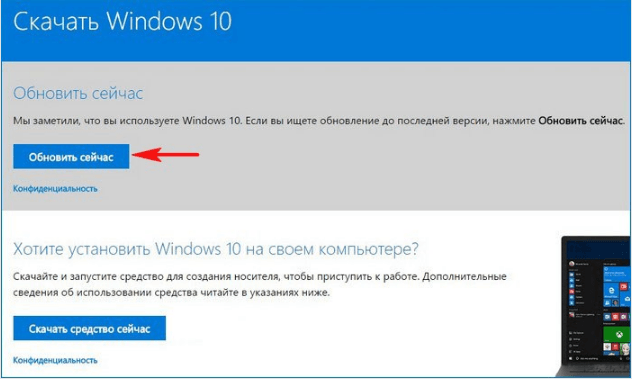 Downloading Windows program 10 Updates from the official Microsoft website
Downloading Windows program 10 Updates from the official Microsoft website Possible settings for home edition
Settings for Windows Home edition are very limited. The only thing that can be changed is the time when the computer will automatically restart. A reboot is only necessary if there are downloaded but not installed updates. You can do it right away or choose one of two options:
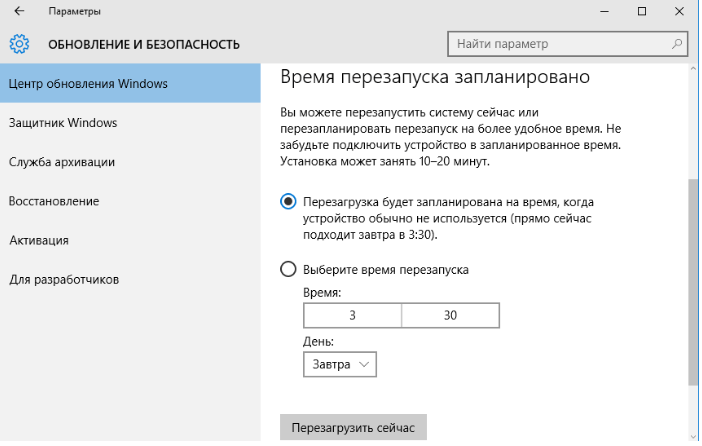
Once you have decided on the reboot period, you can check the update settings.
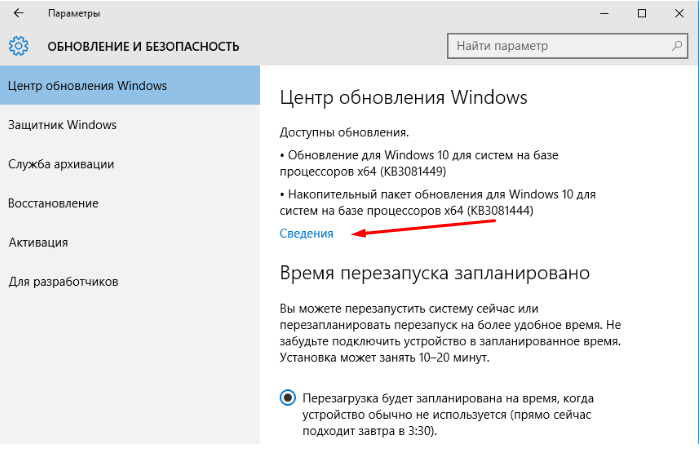
This completes the steps available in the home version of the operating system. All other settings can be made using third party programs, command line, registry editing or other system settings. But to perform deeper settings is strictly recommended only for those who understand this, otherwise the change system settings may lead to errors.
Video: Setting Up Updates in Windows 10
Possible settings for other editions
All Windows Home features described above are available in Professional and higher editions. But besides them, there are other settings that help you configure the conditions for receiving updates in more detail.
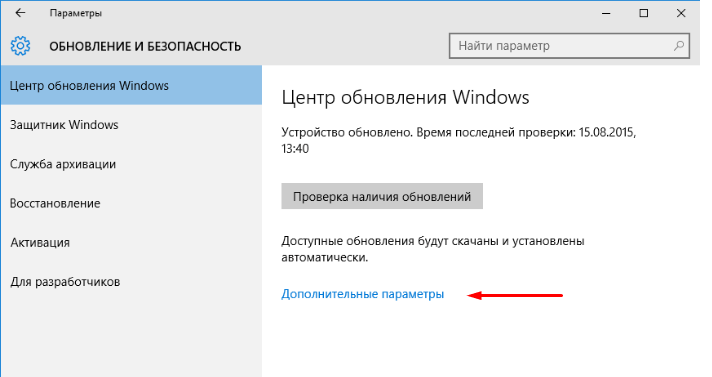
Prohibition of self-updating
If you do not want the computer to install all available updates, you can prevent certain versions from being installed with official program Show and hidden updates, available on the Microsoft website, or completely deactivate the service that downloads updates.




